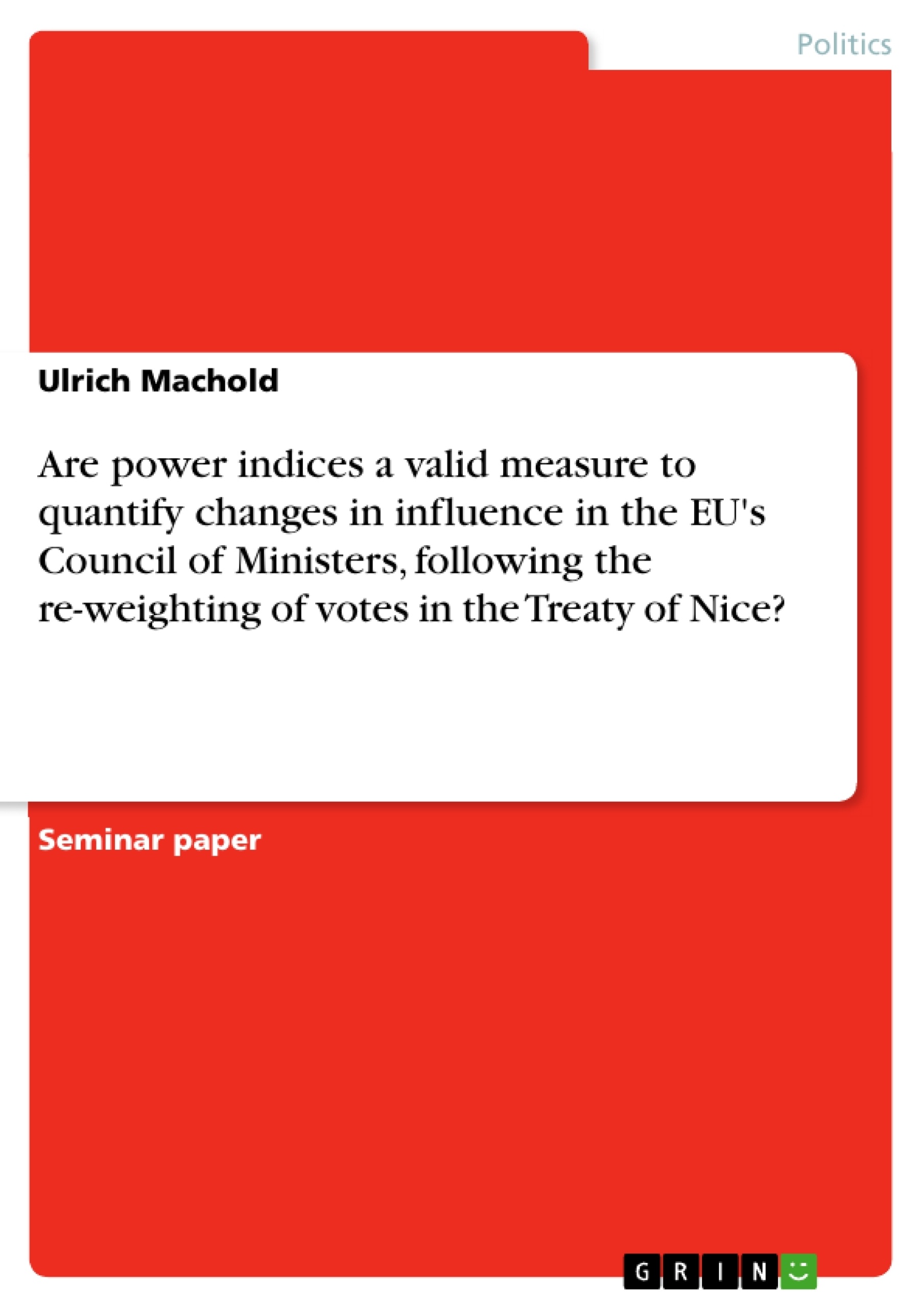I shall firstly summarise M&F′s study and results in order to allow for an easier assessment of the situation. Subsequently, I shall depict the arguments against the application of power indices to an organisation such as the European Union and put them into perspective. In the third part of this essay, I shall then attempt to show that methods proposed as alternatives to power indices do not, in fact, offer any workable alternatives when analysing the EU-Council after enlargement, and conclude that power indices can provide an important approximation of a priori power distribution and do carry relevance in assessing the Council and especially in understanding the behaviour of actors when deciding on issues like the re-weighting of votes in the Nice Treaty.
Inhaltsverzeichnis (Table of Contents)
- The Council of Ministers a power index analysis
- QMV in the Council - past, present and future
- Methodology of the analysis
- QMV after the Treaty of Nice – a change for the better?
- Applying power indices to the EU - a critique
- Arguments against the applicability of power indices to the Council of Ministers
- The concepts of power
- Power indices and 'true power'
- Are there alternatives?
- Power indices versus spatial analysis
- Arguments against the applicability of spatial analysis and for the relevance of power indices
- Power indices in the Council – imperfect, but without any real alternatives
- Conclusion
Zielsetzung und Themenschwerpunkte (Objectives and Key Themes)
This essay critically examines the validity of using power indices to assess changes in influence within the European Union's Council of Ministers, specifically following the vote re-weighting in the Treaty of Nice. The essay aims to defend the concept of power indices, challenge the claims that they are not applicable, and assess the findings of a study by Machover & Felsenthal on this topic.
- The application of power indices to assess influence in the EU's Council of Ministers.
- The critique of power indices and alternative approaches, such as spatial analysis.
- The evaluation of the Treaty of Nice and its impact on voting power in the Council.
- The concept of 'true power' in the context of the EU's complex decision-making structures.
- The potential for power indices to provide valuable insights into the Council's dynamics and the behavior of member states.
Zusammenfassung der Kapitel (Chapter Summaries)
The first chapter provides an overview of Machover & Felsenthal's study, focusing on their analysis of two decision rules for the Council of Ministers: N15 and N27. It discusses the different aspects of the rules, including bloc votes, numerical quotas, and population quotas, and explains the methodology used by M&F to evaluate the rules' impact on voting power.
Chapter 2 presents arguments against the applicability of power indices to the EU's Council of Ministers. It explores the complexities of power in the EU context and highlights the limitations of using power indices to capture 'true power.' This chapter aims to challenge the assumptions underlying power indices and explore the need for alternative methods.
The third chapter explores potential alternatives to power indices, such as spatial analysis, and ultimately concludes that power indices remain a valuable tool for assessing the EU Council. It argues that despite their limitations, power indices can offer an important approximation of power distribution and provide valuable insights into the Council's dynamics, particularly in relation to the re-weighting of votes following the Treaty of Nice.
Schlüsselwörter (Keywords)
This essay focuses on the concept of power indices, the European Union's Council of Ministers, the Treaty of Nice, Qualified Majority Voting (QMV), and the distribution of influence among member states. It also explores related concepts like 'true power', spatial analysis, and the challenges of decision-making in complex inter-institutional arrangements.
- Quote paper
- Ulrich Machold (Author), 2001, Are power indices a valid measure to quantify changes in influence in the EU's Council of Ministers, following the re-weighting of votes in the Treaty of Nice?, Munich, GRIN Verlag, https://www.grin.com/document/9452



